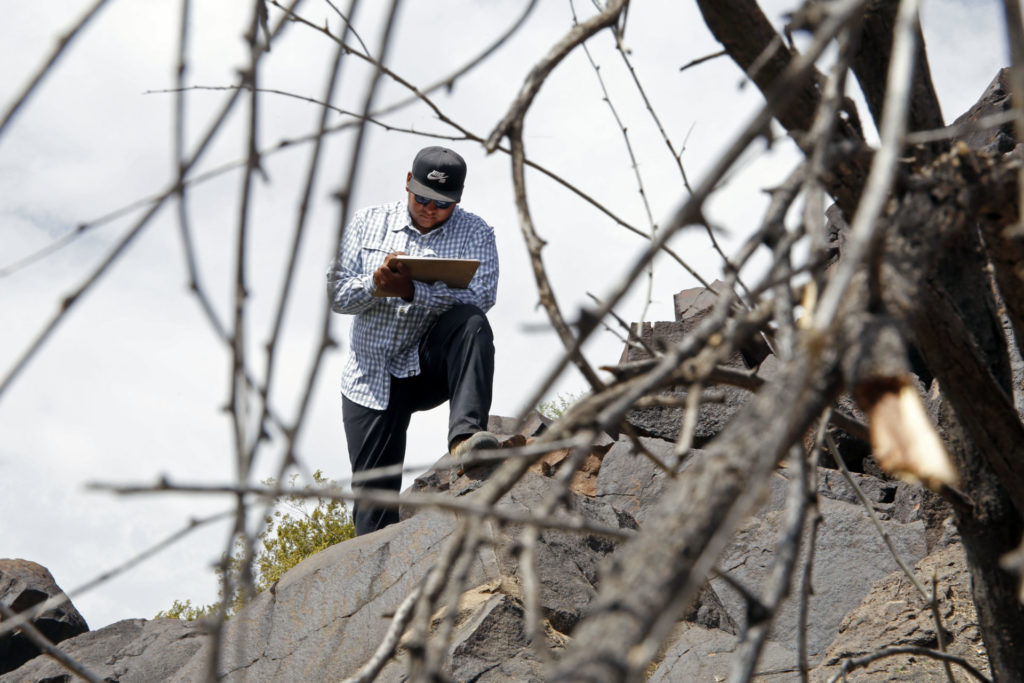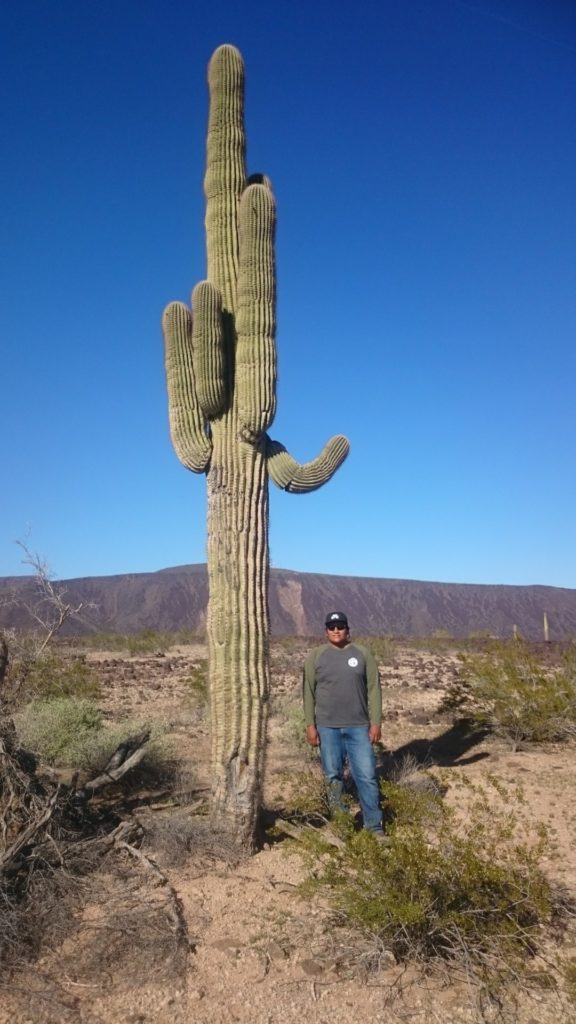- Home
- >
- Preservation Archaeology Blog
- >
- On Archaeology: Skylar Begay
Saturday, October 16, was International Archaeology Day. When we can, we like to commemorate IAD with a blog series. This year, several members of our staff are sharing how they got into archaeology, what they thought the field was, how they think about it now—and even what they think archaeology should be.
We’ll have a new post almost every Friday through the end of the year. Today, we hear from Skylar Begay.
Skylar Begay, Tribal Outreach Fellow
After my position with LGREAP ended, I joined the U.S. Forest Service on an Off-Highway Trail Crew. Still, I kept my eyes peeled for artifacts and petroglyphs as I built and maintained trails in the national forests and Bureau of Land Management (BLM) lands of southwestern Colorado. It seemed I had gained a new lens to view the land through. At the back of my mind, I was searching for the imprints left by those who had lived there long before I was around. When I did come across those imprints, a familiar sense of wonder would overcome me. I would think back to my season in the Great Bend of the Gila. I wondered: If the LGREAP team were here and this was a site we had to document, how would we go about it?

As I explored the Four Corners with this new perspective, I began to seek out public lands not only for a hike or a camping trip, but also to learn about those who had once called these lands home. When I was home, east of Flagstaff, I would take meandering walks on the volcanic cliffs and cinder cones that surrounded my family’s land, looking at the land with that new lens. I found large potsherds, rims, and dwelling sites on land that I had “known” for many years.
Fast-forward to my current position here at Archaeology Southwest (ASW). When I sat down in research meetings with the actual archaeologists employed here at ASW, I found it very difficult to follow their conversations. The technical jargon, references to published works and their authors, and the names of differing time periods, regions, and worlds were overwhelming. Naturally, I began preparing more for those conversations by reading anything related to the topics we’d be discussing, and slowly I became less lost in those conversations—though I have a long way to go before I can hold my own. In many ways, it is like learning a new language and a new way of thinking to put oneself in an archaeologist’s place. I came to see that I had arrived at my relationship with archaeology in an uncommon way. I had built my relationship in a very hands-on and in-the-field way, and now was being shown yet another way of looking at archaeology: a more scholarly approach rooted in research. I came to respect the discipline needed for that aspect of archaeology.
Another aspect of all this was learning about Indigenous views of archaeology, of archaeologists, and about Indigenous archaeologists. Growing up, I was always told by my elders that anything related to those who came before us was to be treated with the utmost respect. I was told that it was okay to pick things up and to take a look, but never to break or remove that artifact from its natural place. Some of my friends were told not to pick up an artifact whatsoever. I was taught that if I knew I was going to be around a site, to be mindful beforehand, and to be very deliberate in walking onto that site with a good intention and energy.
Similarly, I was told to be observant while exploring a new area, so that I would not inadvertently find myself in a site. I was warned that were I to conduct myself disrespectfully, to take any kind of artifact, or to mistreat any part of a site in any way that I would suffer negative consequences inflicted on me by the spirits protecting that site. In addition, even if I were to conduct myself in the best manner possible at a site, I was told to seek a prayer and blessing when I left that site. I should say also that I was taught these tenets as a Navajo, and though some of my friends with differing Tribal affiliations have related similar teachings, I can speak only for myself and my upbringing.
I can remember one particular instance when I was a crew leader for the Arizona Conservation Corps working on the south rim of the Grand Canyon National Park. My crew was comprised of eight Indigenous youth from various Tribes. One project of ours was to do some routine maintenance on the Tusayan Ruins there in Grand Canyon National Park. A few of my crew members outright refused to step in the ruins, and so I had to find other means of having them involved in the project, but off-site. We worked on that project for about a week, and every night we burned cedar or sage, and cleansed ourselves and our living spaces. We had all been taught similarly about how to conduct ourselves in these settings and had all been taught how to protect ourselves according to our own traditional teachings.
I also remember thinking, “I wonder what my grandma would say if I let her know I was working in these ruins?” I elected to wait until I went back home to tell her, and I will admit I was somewhat nervous I might get a stern talking-to when I did. So the next week I informed her, and for a moment she was silent in deep thought. Then, more to herself than to me, she said, “Oh, okay, so that’s why I had that dream.” Perplexed, I asked her what she meant, and she related a dream wherein she spoke with a man who she somehow knew was from the past. He told her that one of her family was on his land, but did not say who. She then said, “Well, we better be safe and burn some cedar for you.” So you see how very real the connection between Indigenous Peoples and our ancestors is, a small part of how we respect that relationship, and the amount of thought, teaching, and effort that is put into maintaining harmony with the past.
I hope the teachings listed above and this story together provide some context for the stigma archaeology and archaeologists carry among Indigenous communities. One can infer just from this how much archaeology clashes directly with traditional teachings and knowledge. Beyond this, there is also the history of the removal of countless artifacts and human remains from their resting places. In most cases, these items and ancestors were dug up and taken without permission from the living descendants of the cultures being studied, and perhaps without even a thought to ask. Even today, Tribes seeking repatriation of artifacts and remains must go through a long, difficult process. In essence, archaeology has played a part in the atrocities suffered by Indigenous Peoples. It is important that this fact is acknowledged by archaeology, archaeologists, and institutions—not to inflict shame and guilt, but so that it is not forgotten and repeated into the future.

This brings us finally to what I think archaeology should aspire to in the future. The immediate change that comes to mind is that there need to be more Indigenous archaeologists. Due to the teachings and stigma I noted, Indigenous people are reluctant to pursue a career in archaeology. It follows that archaeology must change to attract more Indigenous People. Archaeology is fundamentally different from other sciences in that its advancement is accomplished at the expense of living descendant communities if carried out how it has been in the past. Due to this fact, archaeologists must not seek knowledge for the sake of knowledge and should seek that knowledge through less invasive and destructive means to the greatest extent possible. An initiative already taking place here at ASW is using existing databases and resources to find new insights without the use of a trowel or a trench, and this approach needs to be more widespread among institutions. Similarly, institutions should seek to include Indigenous communities in new projects from that project’s inception and should respect those communities’ boundaries and right to grant permissions.
Lastly, archaeological institutions should seek to create opportunities for Indigenous People within their institutions. This would allow more to find their way into archaeology in the nontraditional way I found myself here at Archaeology Southwest. I believe that by including the descendants of the cultures and Peoples that archaeology studies, the changes I have put forth will naturally happen. I also will conclude by saying that my thoughts on how archaeology can improve are far from everything it can and should do, and that including Indigenous Peoples in as many ways as possible will bring to light all else that should change.
8 thoughts on “On Archaeology: Skylar Begay”
Comments are closed.
Awesome entry! My highest regards for your career path in this field!
Keep going brother! So very proud of you.
What an amazing, well-written reflection, and thoughtful inspiring connection to the past ..and future! ❤️
Respect, mindfulness, observation, and do no harm…. recipes for good life as well as good archaeology and stewardship. Thanks Sky!
Thank you for sharing your personal reflections and also your thoughts on how archaeology can best move forward.
Good Job, Skylar! I wish you the best in your continued endeavors and am pleased you have chosen this path. Stay Safe and Good Luck!
I encourage you to make contact with the Havasupai and Hualapai elders and resource managers. Carletta Tilousi is a good person. Feel free to contact me if you want to. I worked with the Havasupai on the threat that the Canyon Mine was going to present to their cultural resources. The Havasuapai held four sacred gatherings in the sage meadow at the base of Red Butte, beginning in 1986 – I think I have the date right.
Thank you, Skylar, for your thoughtful blog entry. I appreciate your honest and forthright analysis of issues related to Indigenous people and archaeological practices. Your vision for the future is one I hope to see enacted, and I think ASW is the right place to begin this work.